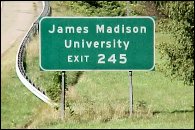The Green Bank Radio Observatory
On the last regular class day of May session, some of us in Mr. Alexander’s PHYS 120 course (Solar System) went down to Green Bank, West Virginia to see what’s going on at the National Radio Astronomy Observatory. Some interesting stuff, indeed. We got to see the tour that is typically given to the public, which entails a small presentation and a bus ride to see all of the telescopes, including the Robert C. Byrd Green Bank Telescope, otherwise known as the GBT. After this, we got a behind-the-scenes look, as we went in to see some of the equipment they use, as well as the command center for the GBT.
One thing that I don’t think many of us were prepared for was the drive over. This was not your typical drive-through-the-back-roads like you’d do throughout most of Virginia. Even though we took Interstate 81 down from Harrisonburg to Staunton, where we met U.S. 250 going west, once you get past Staunton and Churchville, 250 becomes your worst nightmare, as the road goes up and down and around and around, winding around every mountain in its path. We were all so pleased to finally have the GBT in sight, as we knew that the ride was over.
The first sign that the drive (a good 2½ hours) was over – a glimpse of the GBT itself.
So let’s first proceed into the visitors’ center…
And welcome to the visitors’ center! Click the image to see the entire backdrop for the presentation we attended.
And telling us all about the GBT as well as radio astronomy is this guy. He was a good presenter, but he had a few factual errors. He also showed us how liquid nitrogen works, with us freezing pennies and then smashing them with a hammer. Fun!
And now on to the telescopes! This bus was essential for going out there, as it took diesel fuel. Gasoline engines cause too much electromagnetic radiation. Misdirected manmade radio waves are the scourge of radio astronomers, and it was for this reason that the National Radio Quiet Zone was established. This square-shaped area covers parts of eastern West Virginia and western Virginia, including Harrisonburg, to our astonishment.
Many of Green Bank’s telescopes were mothballed when we came through, meaning that they were put on inactive status, and measures were taken to prevent deterioration during their inactive time.
And this, as mentioned before, is the GBT, up close. The GBT can view the entire sky starting at 5º above the horizon and going to the zenith.
This is the feed arm, which holds the secondary reflector as well as the prime focus. Due to the GBT’s unconventional design, this is the only thing blocking the GBT’s “view”. This, however, is compensated for by the GBT’s ability to move around on its base, also enabling it to act as if it were over four times as big as it is.
Be careful where you look when you’re around the GBT. The entire surface is constantly being checked with lasers to ensure it’s the proper shape, and adjusted as necessary.
And here’s a good look at the GBT’s underside and the panels.
From this different vantage point, you can get a good look at the lower-works of the GBT. Also, note that this was a rainy day when we visited. This would prevent your typical backyard astronomer from seeing the sky, but the GBT doesn’t have that problem. Since it’s a radio telescope, it can operate in any kind of light and under any kind of weather except for the most severe storms (and then only in order to protect the telescope from damage).
And now we say goodbye to our tour guide, and head over to the other building for our behind-the-scenes tour.
In the older portion of the building is where the electronics shops and such are.
One of the devices used to collect radio waves.
It’s important to keep the actual collectors clean, thus the saran wrap. Out in the field, saran wrap is impractical for use, and so they actually use this blue foam at right. The blue foam is transparent to radio waves, and keeps stuff out.
This lower part of the collector must be kept very cold to keep waves generated by heat from causing a false reading. How cold? How does a few degrees above absolute zero sound?
Welcome to the GBT’s control room! Generally, at the Green Bank Observatory, you’ve got engineers working during the day, and astronomers working at night.
How much radiation is put off by equipment? We found out using this handheld radio. Regular PCs produce a good amount of radiation, the speakers put out their own electromagnetic radiation, and the list goes on. Even the Mavica puts out a little bit of electromagnetic radiation. Needless to say, this room is shielded, so as to prevent the radiation originating in here from interfering with the GBT.
Behind a wall, we find the equipment behind the GBT. So much equipment to support this telescope. It’s amazing…
And after this, it was back to the ‘Burg. And as we left, a few parting shots of the GBT…


























